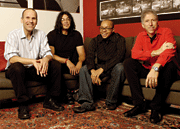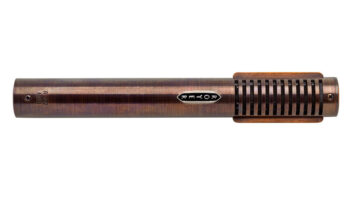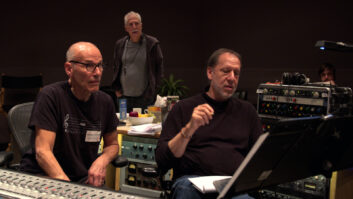
Back in 1981, The Police were in full flush, the recently murdered John Lennon was still being mourned and on the charts with a pair of hits, and Kool & The Gang’s “Celebration” was a crossover smash hit on pop and urban radio. Meanwhile, a quartet of young jazz musicians looking for a sound of their own was woodshedding and getting ready to release their first album. None of them, including pianist Russ Ferrante and bass player Jimmy Haslip, dreamed that a quarter-century later, The Yellowjackets would still be successfully recording and touring.
The Yellowjackets, from left: pianist Russ Ferrante, bassist Jimmy Haslip, drummer Marcus Baylor and saxophonist Bob Mintzer
To commemorate the Yellowjackets’ silver anniversary, the group’s label, Heads Up, released Twenty Five, a live CD/DVD set that features the band’s current lineup — Ferrante, Haslip, tenor saxophonist Bob Mintzer and the newest member of the Yellowjackets, drummer Marcus Baylor. Appropriately, the material the band performs on the CD is culled from the group’s entire history.
The two-time Grammy Award winners (1986 Best R&B Instrumental Performance for “And You Know That” and 1988 Best Jazz Fusion Performance for “Politics”) have always traveled a road somewhere between the popular “smooth jazz” format and more adventurous jazz styles. Ferrante notes, “I wouldn’t say that we’re smooth jazz pioneers, and to tell you the truth, I’m not a fan of the genre at this time. My wife says we should call our music ‘rough jazz’!
“Our first three or four recordings — made in the early ’80s [when guitarist Robben Ford was in the band] — had more of a groove, an R&B sensibility to them. As the years have gone by, that element is still there, but the grooves are looser and more fluid; we’re not a ‘part’-oriented band. Smooth jazz has become so formulaic that it’s lost any sort of originality or spark of inventiveness. You have to paint by the numbers because the radio formats are so strict. None of the guys in our band is remotely drawn to playing by those rules.”
Haslip laughs when asked about the band’s place in the smooth jazz universe. “We hate the term now on a certain level! That terminology wasn’t in existence when we started. Quiet Storm — that was a hip format, with lots of R&B and some smoothness. Don’t get me wrong — there are guys doing some cool things in smooth jazz and I’m a fan of several artists that are cemented in that genre, but my goal is to stretch the boundaries.”
Twenty Five includes an audio CD recorded at the New Morning nightclub in Paris and a DVD that features nearly four hours of live concert footage (recorded in Forli, Italy), interviews with current and past Yellowjackets members and a series of retro concert video clips. All of the new live material was recorded in stereo and 5.1 by Gerald Albo, who handles live sound on the band’s European dates and has been mixing concert and club venues for the past decade.
“I started playing keyboards in a local band in the Dordogne in [central] France,” Albo says. “I was a big Yellowjackets fan back then, so working with the band has been like a dream come true for me.
“I mixed FOH on the equipment at each venue, and the P.A., desk and other gear were different each night. Schoeps was kind enough to lend us microphones for this tour; they also loaned me mics for a tour I did back in 1998 with the McCoy Tyner Latin All-Stars.
“We used lots of microphones, including a ton of [Schoeps] MK-4G capsules on the drums, along with CMC-5s and -6s. We used this same combination to capture the audience in four channels and the piano.
“We also brought along a Mackie Onyx 800R 8-channel mic preamp unit. I decided to use the converters in the Onyx to avoid potential clock problems since there was no spare time on this tour. At some of the concerts, I had to mix FOH, monitor FOH and record — all at the same time! Sometimes we would arrive at the venue in the afternoon, just a few hours before doors opened, so having the simplest and most reliable system possible was vital.
“Another challenge was figuring out how to monitor the recording and mix FOH at the same time. I decided to feed the FOH mixing desk from the output of the Mackie SDR 24/96 we were using. That way, if something went wrong, I and everyone else in the venue would hear it in real time! The Mackie setup was extremely reliable. We didn’t have a single problem during the entire tour.

“The SDR 24/96 has a USB port, which I used each night to back up the evening’s performance once I got into my hotel room,” Albo continues. “It took anywhere from six to eight hours to back up one concert. Some overnight stays were too short to complete a backup, which meant that I was often busy on my days off. When time permitted, I would check the recording on my headphones for any potential issues, monitoring the digital audio through MOTU’s Digital Performer 3.11.
“I was concerned about the acoustics each venue presented — how a room plays can make the difference between good and bad track separation. Drum spill into the piano was always an issue. I don’t like to have the lid fully closed; for these recordings, the lid was always on the short stick. But I had to close-mike the piano to maximize separation and then add a Shure Beta 98 in one of the holes for onstage monitoring.”
Although Albo states, “The Yellowjackets sounded and performed so well that it was easy and great fun to mix them every night,” he says the tour did present some challenges. “Recording the DVD in Forli was actually a bit of a nightmare,” he remembers. “The venue’s acoustics were the worst of the tour, and the promoter provided the wrong backline — the piano was a baby grand and the bass amp was something made locally. Neither Russ nor Jimmy was impressed! After a long ‘negotiating’ session, a grand piano was delivered several hours before show time. Also, I didn’t know the Paris show was going to be mixed in 5.1, but by pure coincidence, I decided to throw up four audience mics — fortunately!”
Mixing both the audio CD and the bonus DVD was handled by Rich Breen, who mixes out of Dogmatic, his home studio located in Southern California. Breen has been working with The Yellowjackets for about 10 years now and has an extensive discography that includes many acoustic jazz, pop and orchestral productions.
“I know the guys had been bouncing around the idea of recording a live DVD for some time,” says Breen. “Gerald Albo is a fine soundman, and we spoke about economical ways to shoot the whole tour without bringing in trucks. We decided on the Mackie SDR 24/96 and a handful of FireWire-connected mic pre’s. We used a total of 24 channels of mic pre’s, and I sent over a handful of drives.
“I’ve been mixing in a guest house behind the main house on my property for the last 10 years or so, and I’m extremely comfortable here. I was technical manager at Universal in Chicago for many years, so I tuned the room myself. I mix on a Pro Tools HD 3 system with a Control|24.
“With a band like The Yellowjackets, the drummer is always the issue,” Breen continues. “They’re a backbeat, as well as a jazz band, and on these dates, the piano was sitting about 10 feet from the kit, with the lid open. It’s always a challenge when you have the drums and bass pouring into the piano on an electric date. Fortunately, the Schoeps mics were in fairly close and the lid was on the short stick.
“Still, there are always going to be spillage issues. You have to EQ the piano judiciously and live with the rest. Mostly, we ended up taking out some low-mid resonance, in the 200-ish range, because of the open lid. I also added a highpass filter at around 80 or so to calm down some of the low-frequency stuff coming from the stage. But we didn’t do anything radical — no more than a 5dB cut on anything. I can’t say enough about the Schoeps microphones. They sound fantastic on the piano.
“As far as the 5.1 field, I would have preferred to have had four microphones across both the front and back, but due to track count and the fact that the show was traveling daily, we went with a total of four instead. To create ambience in the mix, I worked with an [Audio Ease] Altiverb ‘small club’ setting and an ambient setting on my TC [Electronic] System 6000. The 6000 is a four-engine reverb, and it sounds beautiful. I had all four engines going: a general plate, a ‘room’ for the drums, another little short [reverb] to add some more fat to the drums and a ‘club’ going for the front ambience. The plate is for the sax, piano and keyboards. I’m a little old-school in that I like plates a lot.”
Ferrante and Haslip seem genuinely humbled by their success and by the willingness of their fan base to share their journey with them. “It’s been fun and sobering, as well,” says Ferrante. “My overwhelming feeling — all the guys feel this way — is gratitude. We’re fortunate that we happened into this situation, we appreciate it a lot and we’re having fun. When you’re young as a musician, you want to come out and play the hippest stuff, be out on the edge every moment. Although I still enjoy that, I’m appreciating that these songs that people have connected with are a gift. If you realize as a musician that it’s a gift you’re sharing, you enter into that joyful place when you’re making music. That awareness has transformed things for me and taken the pressure off. Connecting with your band mates and those people that are listening to you — and not in some phony, contrived way — is the essence of the experience.”
“I can’t believe it’s been 25 years!” adds Haslip. “But when I look at it on paper, it’s undeniable! To have been in an outfit that’s been ebbing and flowing, with all the ups and downs, for that long — that’s awfully inspiring. I feel honored and privileged to have been part of this band.”




